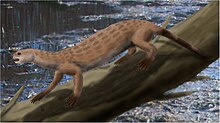Puijila darwini
| Puijila darwini | ||||||||||||
|---|---|---|---|---|---|---|---|---|---|---|---|---|

Skeleton of Puijila darwini |
||||||||||||
| Temporal occurrence | ||||||||||||
| Chattium to Aquitanium | ||||||||||||
| 24 to 21 million years | ||||||||||||
| Locations | ||||||||||||
| Systematics | ||||||||||||
|
||||||||||||
| Scientific name of the genus | ||||||||||||
| Puijila | ||||||||||||
| Rybczynski , Dawson & Tedford , 2009 | ||||||||||||
| Scientific name of the species | ||||||||||||
| Puijila darwini | ||||||||||||
| Rybczynski , Dawson & Tedford , 2009 |
Puijila darwini is a primitive ancestor of the seals who lived 21 to 24 million years ago during the Oligocene and Miocene . It is the only known species in the genus Puijila and was scientifically described in 2009. The animal was about three feet long and had minimal physical adaptations for swimming. Unlike modern seals, Puijila darwini had no fins and its general shape was otter-like. However, the skull and teeth show characteristics that clearly identify them as relatives of the seals. Puijila darwini is the most primitive member of the seal kin discovered to date. The generic name comes from the Inuktitut languageand means "young seal". The species epithet honors Charles Darwin , who would have turned 200 in 2009 and who pointed out the development of seals early on. The only known specimen is a 65 percent preserved fossilized skeleton that was unearthed in Haughton Crater on Devon Island in Nunavut . It is kept in the Canadian Museum of Nature in Ottawa , Ontario .
background
Puijila darwini was a semi-aquatic predator that represented a morphological mosaic shape in the early seal development. The fossil remains show enlarged, probably webbed feet, strong front legs and an unspecialized tail. This suggests that Puijila paddled four-legged and used the webbed front and rear legs for propulsion. Phylogenetic studies, including molecular evidence, suggest a sister relationship between seals , bears, and martens (weasels and otters). Originally it was assumed that land mammals would at some point adopt a more marine way of life, essentially "returning to the sea" in order to gain some sort of survival advantage. However, fossil evidence for this transition has so far not been tangible or controversial. The discovery of Puijila is significant in that it is a transition fossil ( missing link ) that reveals information about how the seal group may have made the transition into the sea. Puijila was related to the fossil seal genera Enaliarctos and Potamotherium .
discovery
Remains of this new species were unearthed in 2007 and 2008 by Canadian paleontologist Natalia Rybczynski and her team in the deposits of an early Miocene lake in the Haughton Formation on Devon Island in Nunavut , Canada. Paleobotanical records suggest that the paleoenvironment around the lake comprised a forest landscape in the transition between a boreal forest and a coniferous deciduous forest. The weather was determined by a cool, temperate coastal climate and moderate winters. Puijila darwini is the first carnivorous mammal fossil to be brought to light in the Haughton Lake deposits. At the same time, the find could be an indication that the evolution of seals began in the Arctic.
Individual evidence
- ^ A b Ed Yong: Puijila , the walking seal - a beautiful transitional fossil . ScienceBlogs.com. April 24, 2009. Archived from the original on September 1, 2012. Info: The archive link was automatically inserted and not yet checked. Please check the original and archive link according to the instructions and then remove this notice. Retrieved December 14, 2012.
- ↑ Puijila: A prehistoric walking seal . Canadian Museum of Nature. Archived from the original on June 21, 2015. Info: The archive link was inserted automatically and has not yet been checked. Please check the original and archive link according to the instructions and then remove this notice. Retrieved December 14, 2012.
- ↑ Richard Black: 'Missing link' fossil seal walked . In: BBC News , April 22, 2009. Archived from the original on May 1, 2009. Retrieved on December 14, 2012.
- ↑ Rybczynski, N., Dawson, MR, Tedford, RH: A semi-aquatic Arctic mammalian carnivore from the Miocene epoch and origin of Pinnipedia . In: Nature . 458, No. 7241, 2009, pp. 1021-24. doi : 10.1038 / nature07985 . PMID 19396145 .
Web links
- Puijila darwini website
- Natalia Rybczynski at the Canadian Museum of Nature
- Brian Switek, Puijila darwini : A Significant Seal .
- Robert Boessenecker, Puijila , a very basal 'pinnipedimorph' .
- Ed Yong, Puijila , the walking seal - a beautiful transitional fossil .
- "Fossil seal had the feet of an otter" by Bob Holmes, New Scientist , April 25, 2009, p. 10.

